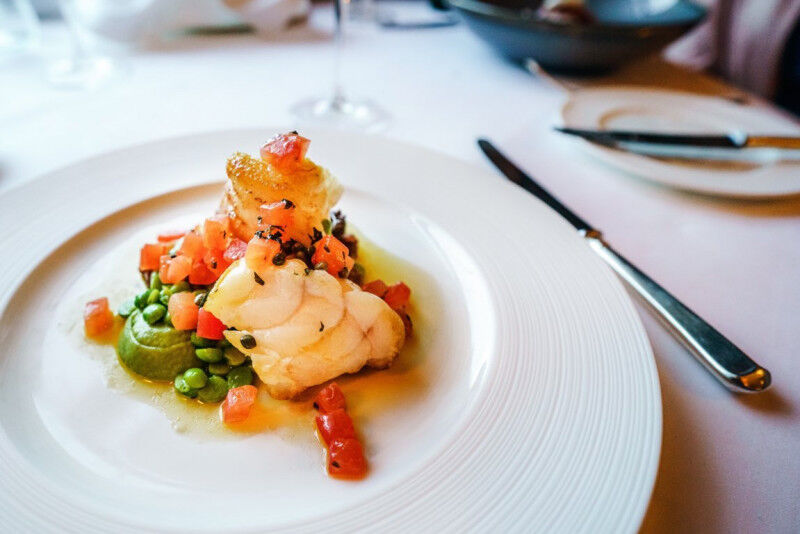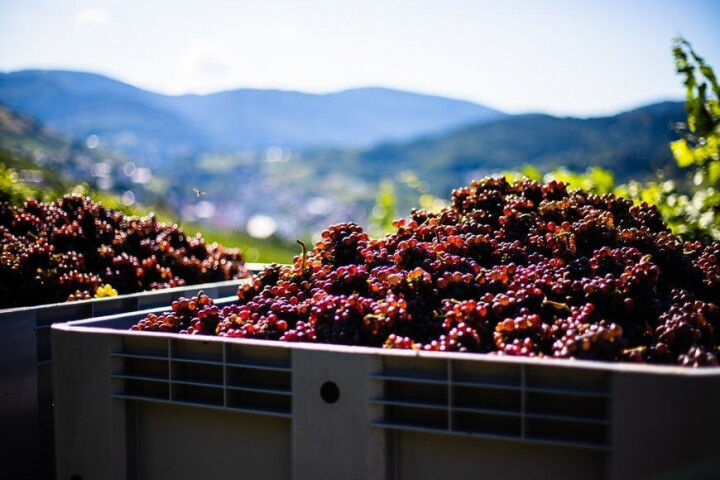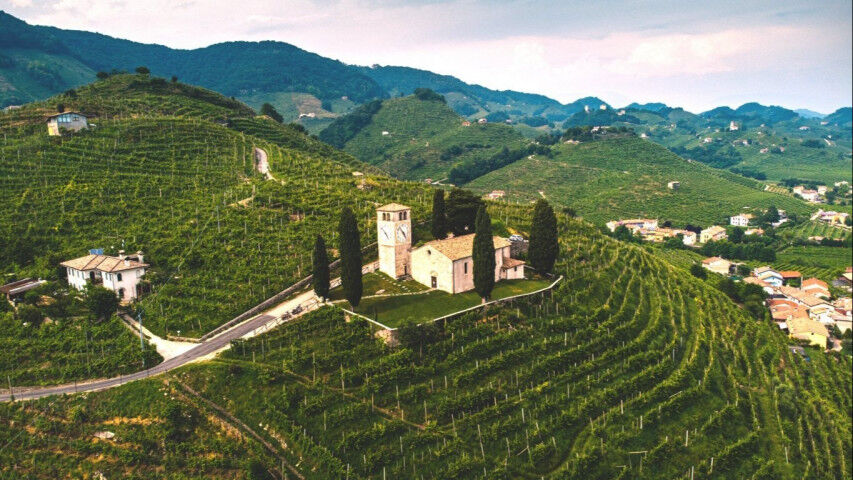Pinot Grigio and Chardonnay
Pinot Grigio and Chardonnay have a few things in common. Firstly, they both produce popular dry and off-dry white wines. Secondly, wines from both of these grapes cover a range of quality levels, from easy-drinking to complex styles. Thirdly, they’re both widely planted across the globe although Chardonnay occupies more vineyard hectares than Pinot Grigio. They also both have a similar color and alcohol level. However, where these varieties differ is in the hues of their skins, aroma, and flavor profiles, and the regions where each is prominent.
Pinot Grigio
Pinot Grigio hails from Burgundy in France where its parent Pinot Noir also thrives. It’s known as Pinot Gris (France and French style wines) and Grauburgunder (Germany). In fact, as with most Vitis vinifera grapes, Pinot Grigio has numerous names!
Northern Italy is admired worldwide as a benchmark producer of Pinot Grigio. Alsace in France and Oregon in the northwest of America also make prestigious wines from this variety. In Italy, Alto Adige, Friuli-Venezia Giulia, and Lombardy are the chief areas for Pinot Grigio production. Friuli-Venezia Giulia is famous for premium quality Pinot Grigio which bears little resemblance to the neutral, easy-drinking mass-produced wines from the Veneto plain.
Main characteristics of Pinot Grigio
Pinot Grigio has a pinkish-grey skin. This is because it’s a mutant of the ancient black Pinot Noir variety.
Pinot Grigio is light-bodied with delicate, elegant aromas and flavors.
Aromas and flavors include citrus (lime and lemon), orchard fruit (pear and apple), stone fruit (white nectarine), ginger, and spice.
Pinot Grigio also has honey and floral tones, bitter almond, and mineral salinity.
Italian expressions of this grape are usually brightly acidic.
High-volume Italian Pinot Grigio and some Alsace Pinot Gris are off-dry.
Abv level is 11.5% to 13.5%.
Examples of Pinot Grigio
- Pinot Grigio, Abbazia di Novacella 2019 , Alto Adige, Italy
- Signature Collection Pinot Grigio, Alessandro Berselli, 2020, Friuli-Venezia Giulia, Italy
- Pinot Grigio delle Venezie, Piccini, 2020, Veneto, Italy
Chardonnay
Like Pinot Grigio, Chardonnay comes from France’s Burgundy area, and it’s grown in just about every wine region in both the Old and New Worlds. It’s often seen as a blank canvas for winemakers because it’s classed as non-aromatic. This means that growers and winemakers can experiment with different techniques to craft an interesting wine – something that’s avoided with more aromatic varieties. The result is that Chardonnay can display high acidity and green fruit in a spot like Chablis and tropical fruit with high alcohol in California. The expression of this grape varies greatly in character across regions and countries, a feature that makes it very drinkable and popular.
In Italy, it’s widely planted for both high-volume IGT wines and top-tier classifications. Chardonnay is found everywhere from the cool climes of Piedmont where it has a DOC in Langhe to the hot vineyards of Sicily. Champagne is also a key grape in Champagne Method sparkling wines around the world including Franciacorta in Brescia in Lombardy.
Main characteristics of Chardonnay
Chardonnay is a green-skinned grape.
Young cool climate wine is acidic with green apple and citrus and a light to medium body.
Warm climate Chardonnay features stone fruit and tropical fruit with gentle acidity and a full body.
Winery techniques and maturation can add butter, cream, vanilla, coconut, spice, and toasty notes.
Chardonnay can be produced in both a simple fruity style for early drinking and complex, premium expressions.
Top-tier Chardonnay can age for years.
In warm regions, it can reach 14.5% abv.
Examples of Chardonnay:
- 940 Riserva Brut Franciacorta 2011, Le Quattro Terre, Lombardy, Italy
- Chardonnay 2018, Feudo Disisa, Sicily, Italy
- Maturum Chardonnay 2018, K. Martini & Sohn, Trentino-Alto Adige/Südtirol, Italy
Pinot Grigio vs Chardonnay: Origin
Pinot Grigio is a mutation of the legendary Burgundy grape Pinot Noir plus it’s a distant cousin of Chardonnay. After it emerged in Burgundy, it traveled to Switzerland where it was a popular wine among the nobility. The grape’s next stop was over the Alps into northern Italy where it has thrived since. Today, Pinot Grigio/ Gris is cultivated in many European countries with outstanding wines produced in Italy, Alsace in France, and Germany. It’s also widely planted in all the major New World wine regions.
Chardonnay
Like Pinot Grigio, Chardonnay hails from that cradle of grape varieties, Burgundy. In former times, it was often confused with Pinot Blanc. Ampelographers have established that Chardonnay is a cross between Pinot noir and a lesser-known grape called Gouais Blanc. Chardonnay has easily spread around the world because it’s easy to cultivate and very malleable in the winery meaning vintners can leave their mark on it. Benchmark expressions come from Burgundy, and it features in wine portfolios of many European winemaking areas. It’s also a big grape in New World wine-producing nations where it’s produced for high-volume wines and crafted for premium wines. Outside France and Italy, Pinot Grigio is Oregon’s leading white grape. In this northwestern US area, it’s known as Pinot Gris.
Pinot Grigio vs Chardonnay: Grapes
Oenologists think that Pinot Grigio comes from the Burgundy region in France where its highly-revered parent, Pinot Noir lives. Pinot Noir has produced numerous mutations with Pinot Gris being one of the more famous. Like its parent, Pinot Gris is an early budding and early ripening variety.
It can produce wines that range from delicate and acidic to medium to full-bodied and rich depending on where it’s grown. Northern Italy is renowned for Pinot Grigio wines, but the quality varies across the region. In Alto Adige and Friuli-Venezia Giulia grapes are similar to the smaller berries found in France and Germany so wines have greater concentration. On the Veneto plains, a larger grape with more dilute flavors is cultivated for high-volume wines.
Chardonnay
This popular grape hails from Burgundy and is an early budder. This can pose a threat to Chardonnay as spring frosts are common in this area. However, vignerons have many methods to combat this and have built a benchmark reputation for Chardonnay that’s a reference point around the globe. It produces wines that range from eye-wateringly acidic Chablis in northern Burgundy to rich, layered, full-bodied styles found in California and Australia. As well as making high-end wines, Chardonnay is planted in hot fertile regions in the South of France, Chile, Australia, and California for the production of easy-drinking wines.
Pinot Grigio: Tasting Notes
Pinot Grigio’s aromas and flavors vary depending on where it’s grown and how it’s vinified. In Italy, a typical Veneto plain, off-dry Pinot Grigio features light citrus and stone fruit notes, and high acidity. In Alto Adige and Friuli-Venezia Giulia, a dry Pinot Grigio displays more finesse and depth, with layers of citrus and stone fruit, minerality, ginger and floral notes. On the whole, Pinot Grigio is a food-friendly wine. To pair it successfully, it’s best to think in terms of dry and off-dry and what dishes match best with these components.
Appetizers: Shrimp or oyster starters, mozzarella and tomato, crudités, pitta bread and hummus, and even potato chips (the salt enhances the wine’s fruitiness).
Entrées: Lightly herby chicken, sushi, artichoke salad with fennel and asparagus, fried fish (the acidity cuts through the fat), seafood salad, pasta with light creamy sauces. Off-dry Pinot Grigio goes well with slightly spicy Asian dishes because the sugar and chili heat balance one another.
Dessert: White and dark chocolate, fruit platters, crème brulee.
Cheese: Gruyère, Brie, Mozzarella.
Chardonnay: Tasting Notes
Chardonnay can range from very light-bodied and acidic to full-bodied, lush, and tropical depending on where it’s cultivated. When it comes to pairing this grape with food, one of the best guides is whether it’s oaked or not since this aroma and flavor shines through with spice, toast, and butter when present. Of course, it’s also a key grape in sparkling wine like Franciacorta and bubbles need a unique approach with food pairing.
Unoaked Chardonnay
Appetizers: Charcuterie, seafood starters, light cheese, olives and dips.
Entrées: Sushi, chicken salad, seafood salad, grilled fish, green pea risotto.
Dessert: Fruit platter.
Cheese: Brie, Goat’s Cheese, Parmesan.
Oaked Chardonnay
Appetizers: Creamy soup, charcuterie, seafood starters.
Entrées: Lobster, crab, or scallops, grilled salmon, seafood risotto, creamy pasta, paella.
Dessert: Fruit platter, crème brulee.
Cheese: Brie, Gruyère, Emmental, Camembert.
Sparkling Chardonnay
A glass of dry Franciacorta is an ideal aperitif to warm up the palate. It’s also perfect served with tempura vegetable or fish nibbles since the acidity and bubbles complement the fat. A demi-sec Franciacorta pairs well with light creamy sweets like crème brulee so save it until last!



